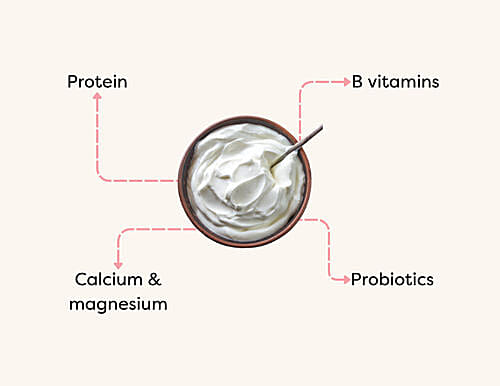Yoghurt & gut health
30th May 2024
Yoghurt is not only delicious but also packed with protein, calcium and probiotics that support gut health. Its versatility makes it perfect for any recipe or a refreshing treat on a sunny day.
Key points
Health benefits
Eating yoghurt and other fermented dairy is associated with:
- Gut health, due to ‘probiotics’ which improve the composition of the gut microbiota.
- Bone health: A higher yoghurt intake was associated with a 24% reduction in the risk of hip fracture in postmenopausal women.
- Mental health, including a decreased risk of depression, potentially via the gut-brain axis.
- Lower risk of type 2 diabetes: Eating 80-125g of yoghurt daily was linked to a 14% lower risk of type 2 diabetes in healthy and older adults.
- Lower mortality risk from cardiovascular disease and all causes.
If you’re lactose intolerant, fermented dairy like yoghurt can be a good alternative because the probiotics involved could improve lactose digestion and symptoms of intolerance.
What’s in yoghurt?
- Protein with all the essential amino acids. They help keep you full for longer and improve your blood glucose response.
- Minerals and vitamins, particularly calcium, magnesium and B vitamins.
- Probiotics which support a healthy gut and immune system.

But not all yoghurts provide the same benefits. Here’s what to look for in the shop!
What to look for in the shop
The yoghurt spectrum: While there is good evidence that yoghurt can be beneficial to health, the products you’ll find in the shop come in a range of qualities. Some are packed with sweeteners, flavourings or thickeners, which can impact their health effects.
Look for:
✅ Live cultures: Check for something like “contains live and active cultures” and if possible the name of specific strains like Lactobacillus bulgaricus, Bifidobacterium bifidum and Streptococcus thermophilus, among others.
✅ Low sugar <5g per 100g: A 2016 survey of yoghurt products sold in major UK supermarkets found that less than 9% of products passed the low-sugar check (≤5 g/100 g) and almost none in the children’s category.
✅ No added ingredients: It’s common for manufacturers to add flavourings and thickeners like starch, pectin, gelatin or Guar Gum to create thickness and creaminess. Look for a short ingredient list – ideally 2 ingredients: Milk & cultures
✅ High protein >5g per 100g
✅ Full fat
Plus: If you can, look into artisanal products—they’re often made in small batches and are transparent about ingredient quality and processing methods.
Avoid: Reduced fat, flavourings, thickeners (pectins, guar gum) and sweeteners like sugar, corn sweetener, corn syrup, dextrose, fructose, fruit juice concentrate, glucose, etc.
Why full-fat?
- Despite concerns about saturated fats, current research does not suggest harmful effects of full-fat dairy foods.
- The biological effects of dietary fats depend on fatty acid chain length and how they’re packaged (’food matrix’). Beyond fats, fermented dairy products are also rich in micronutrients, proteins and probiotics that support metabolic health.
- It’s important to ask: what’s taking the place of fat in low-fat products? Often it’s a combination of sugars and processed starches to preserve palatability.
Greek vs regular
- Authentic Greek yoghurt is also called ‘strained yoghurt’ because it’s traditionally made by straining regular yoghurt until its volume is reduced – much of the liquid whey is removed and it becomes thicker and creamier.
- Greek-style yoghurt can be made by ultrafiltration or by adding milk protein concentrate (such as whey concentrates) and thickeners (such as gelatin and modified corn starch) to regular yoghurt.
Our take: Greek yoghurt contains more protein than regular yoghurt but it’s also more expensive, sometimes contains thickeners (greek-style) and it has slightly less calcium and potassium. We like to focus on choosing quality yoghurt with minimal ingredients rather than one type over the other.
Ways to enjoy
- Salad dressings & sauces like tzatziki or raita.
- Frozen treat, mixed with chopped fruits and pop in the freezer.
- Yoghurt bowl, topped with stewed berries, sliced fruits, nuts, seeds, toasted coconut, peanut butter, etc.
References/sources
Health benefits: Le Roy et al. BMC Microbiol. 2022 | Luo et al. PLoS One. 2023 | Salas-Salvadó et al. J Nutr. 2017 | Ong et al. Adv Nutr. 2020 | Tutunchi et al. Public Health Nutr. 2023
Lactose tolerance: Savaiano et al. Nutr Rev. 2021
Low-fat vs full fat: Schmidt et al. Am J Clin Nutr. 2021
Sugar content in UK products: Moore et al. BMJ open. 2018
